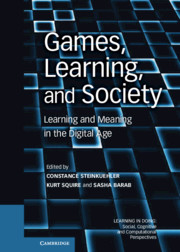Book contents
- Frontmatter
- Contents
- Contributors
- Series Foreword
- Foreword
- Acknowledgments
- Section I Games as Designed Experience
- 1 Introduction to Section I
- 2 Designed Cultures
- 3 Theme Is Not Meaning
- 4 Our Cheatin’ Hearts
- 5 Playing the Odds
- 6 Nurturing Lateral Leaps in Game Design
- 7 Uncharted 2: Among Thieves – How to Become a Hero
- 8 Interview with Harmonix
- 9 Yomi
- Section II Games as Emergent Culture
- Section III Games as Twenty-First-Century Curriculum
- Index
3 - Theme Is Not Meaning
Who Decides What a Game Is About?
Published online by Cambridge University Press: 05 August 2012
- Frontmatter
- Contents
- Contributors
- Series Foreword
- Foreword
- Acknowledgments
- Section I Games as Designed Experience
- 1 Introduction to Section I
- 2 Designed Cultures
- 3 Theme Is Not Meaning
- 4 Our Cheatin’ Hearts
- 5 Playing the Odds
- 6 Nurturing Lateral Leaps in Game Design
- 7 Uncharted 2: Among Thieves – How to Become a Hero
- 8 Interview with Harmonix
- 9 Yomi
- Section II Games as Emergent Culture
- Section III Games as Twenty-First-Century Curriculum
- Index
Summary
At first glance, the popular board game Ticket to Ride seems to be another link in the great chain of rail baron games, such as Age of Steam, Eurorails, and the 1830 series. During the game, the player draws unique route challenges to connect certain pairs of cities – New York to San Francisco, Miami to Chicago, and so on.
To complete them, the player must claim a series of tracks that connect adjacent cities while also trying to block opponents from finishing their own challenges. There are subgoals too, such as having the longest contiguous rail line and completing one’s network first, which ends the game for everyone.
Thus most players would describe Ticket to Ride as a game about building the best rail service by grabbing choice routes and cutting off the competition. However, the Introduction in the rules tells a different story:
On a blustery autumn evening i ve old friends met in the backroom of one of the city’s oldest and most private clubs. Each had traveled a long distance – from all corners of the world – to meet on this very specific day . . . October 2, 1900 – twenty-eight years to the day that London eccentric Phileas Fogg accepted and then won a £20,000 bet that he could travel Around the World in 80 Days.
Each succeeding year, they met to celebrate the anniversary and pay tribute to Fogg. And each year a new expedition (always more difi cult) was proposed. Now at the dawn of the century it was time for a new impossible journey. The stakes: $1 million in a winner-takes-all competition. The objective: to see which of them could travel by rail to the most cities in North America – in just seven days.
- Type
- Chapter
- Information
- Games, Learning, and SocietyLearning and Meaning in the Digital Age, pp. 32 - 39Publisher: Cambridge University PressPrint publication year: 2012
- 2
- Cited by



